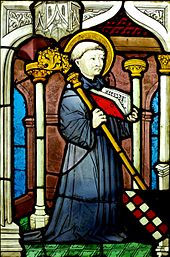Council of Vézelay
Deputations of the bishops of Armenia solicited aid from the pope, and the King of France Louis VII also sent ambassadors.
[3] According to legend, not long before the end of the first millennium a monk named Baudillon brought relics (bones) of Mary Magdalene to Vézelay from Saint-Maximin-la-Sainte-Baume.
In 1058 Pope Stephen IX confirmed the authenticity of the relics, leading to an influx of pilgrims that has continued to this day.
Vézelay Abbey was also a major starting point for pilgrims on the Way of St. James to Santiago de Compostela, one of the most important of all medieval pilgrimage centres.
Louis VII of France, his wife, Eleanor of Aquitaine, and the princes and lords present prostrated themselves at the feet of Bernard to receive the pilgrims' cross.
The full text has not survived, but a contemporary account says that "his voice rang out across the meadow like a celestial organ"[5] When Bernard was finished the crowd enlisted en masse; they supposedly ran out of cloth to make crosses.
Bernard found it expedient to dwell upon taking the cross as a potent means of gaining absolution for sin and attaining grace.
On 31 March, with King Louis VII of France present, he preached to an enormous crowd in a field at Vézelay, making "the speech of his life".
[5] The full text has not survived, but a contemporary account says that "his voice rang out across the meadow like a celestial organ"[5] James Meeker Ludlow describes the scene romantically in his book The Age of the Crusades: A large platform was erected on a hill outside the city.
The enthusiasm of the assembly of Clermont in 1095, when Peter the Hermit and Urban II launched the first crusade, was matched by the holy fervor inspired by Bernard as he cried, "O ye who listen to me!


